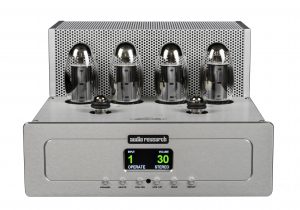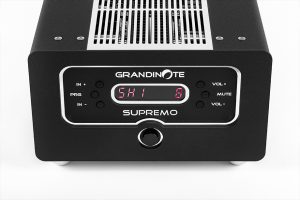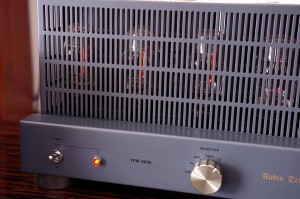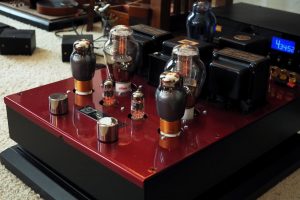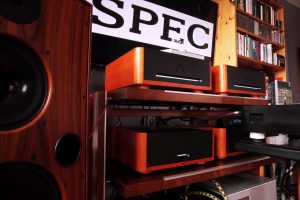I'll elaborate on that later but let me start with information that products by Slovenian company Audio Alto are custom made—to be exact they are made to satisfy first of all needs and expectations of their designer, who says that "they reflect my [sound] philosophy". It's not only about perfect reproduction of the sound that preserves all the purity, openness, width and depth of the original but also about product's aesthetic perfection. Once you take a look at his amplifier's—DMI 3H—design that is quite original, you'll see that he is serious about his statement. This is a particularly low profile device and it is its depth that is impressive. Chassis is made of thick aluminum plates. All electronic circuits are fixed to the front of the chassis, just like in many tube amplifiers. Make & finish is simply perfect.
It's not a coincident that design follows some solutions usually applied in tube amps, as Mr. Burian considers a class A SET (single ended triode) to be the ultimate choice and so his top products are ones. As he says, a huge advantage of this solution is a perfect linearity obtained without any feedback loop, that he personally blames for many issues of amplifiers in general. It is possible, he says, to create a solid-state amplifier circuit without feedback, but it requires using more elements which creates a longer path for the signal and increases a price of the device, also because all elements must be hand-picked which means that one can't manufacturer a larger quantity of such devices. But a small size manufacturer like Audio Alto is able to do it that way.
DMI 3H
The model under review, DMI 3H, is a hybrid, integrated amplifier, with its all sections working in class A without negative feedback. Input features ECC88 double triodes. Other (matching type) tubes might be used instead—we received amp with NOS 6DJ5 valves (JAN type). Output stage works in class A in push-pull configuration delivering 30 W @ 8 Ω and 50 W @ 4 Ω. Although one couldn't tell by looking at this amplifier inside there are in fact two mono amps, in dual-mono configuration, with separate power supplies for each channel. Both channels are isolated with thick screens thus improving separation between them.
It's incredibly well made device that has a lot to offer in terms of functionality too. There are four inputs and one of them might be used for optional MM phonostage module, another serves as tape out, and the next one features lower sensitivity so that with sources like CD Players (usually delivering a 2V signal) volume control could operate within similar (optimal) range. Amplifier features also tone control called "Tilt", that some of you might know from QUAD amplifiers, that operates around 1 kHz point—one can shift accent toward bass range decreasing at the same time treble, or do the opposite—more treble that equals less bass. Also damping factor for output is adjustable—switch sitting on the rear panel allows user to choose between two values: 15 and 50.
I'm sure most of you had to face some problems with remote controls at some point—some just were not very appealing in aesthetic terms, some didn't work when not directed at the receiver, or if too far from a device. The black 'pole' offered by Audio Alto with DMI3H solves all these issues. This remote looks damn good, uses radio frequencies to send commands so can be operated from afar, and it features only few, key functions thus having only few buttons.
A few simple words…
SAŠA BURIAN
Owner, designer
DMI 3H is an Audio Alto entry level model and as the rest of the line is little bit unconventional as it is a hybrid and also without any global negative feedback. The amplifier includes all optional (the remote control, MM phono card etc.).
The concepts of all the amplifying stages (operational amplifiers or vacuum tubes) are in a way "non conventional" as it was my goal to amplify the signal from input to output with stages working in class A, so that there will be no crossover distortion. I'm convinced that this approach can be heard through the listening (it should be pleasant end effortless).
The amp is a A model with 50W/4ohm and 30W/8ohm. The stronger model (B) will be finished in a week or two and it will be offered in the same price.
SOUND
Recordings used for the test (a selection)
- Filia Praeclara, performed by Ensemble Peregrina, Divox CDX-70603, CD (2008)
- Ludi Musici, conducted by Jordi Savall, performed by Hesperion XXI, Alia Vox AV 9853, CD (2007)
- Anna Maria Jopek, Barefoot, Universal Music Polska 016 299-2, "Promo Copy", CD (2001)
- Galahad, Sleepers, Avalon Records GHCD4, CD (1995)
- Galahad, Sleepers, Avalon Records/OSKAR Productions OSKAR 1065 CD, CD (1995/2015)
- Grateful Dead, The Best of Grateful Dead, Rhino 2795598, 2 x HDCD (2015)
- Jean-Michel Jarre, Electronica. Vol. 1: The Time Machine, Sony Music Labels SICP-30788, BSCD2 (2015)
- Johann Sebastian Bach, St. John Passion, BWV 245, conducted by Kenneth Slowik, performed by Smithsonian Chamber Players and Chorus, Smithsonian Collection Of Recordings ND 0381, 2 x CD (1990)
- Megadeth, Fatal Illusion, Universal Music Japan UICY-5130, SP CD (2015)
- Oliver Nelson, The Blues and The Abstract Truth, Impulse!/Esoteric ESSI-90136, SACD/CD (1961/2015) w: Impulse! 6 Great Jazz, Impulse!/Esoteric ESSI-9013/8 (2015)
- Pink Floyd, The Endless River, Parlophone Records 4621333, CD + Blu-ray (2014)
- Richard Strauss, Also Sprach Zarathustra, conducted by Zubin Mehta, performed by Los Angeles Philharmonic, Decca/Lasting Impression Music LIM K2HD 035, K2HD CD (1968/2008)
- The Modern Jazz Quartet, Pyramid, Atlantic Records/Warner Music Japan WPCR-25125, "Atlantic 60th", CD (1960/2006)
- Thelonious Monk, Brilliant Corners, Riverside/Universal Music Japan UCCO-9220, "Jazz The Best. Legendary 100 | No. 20", CD (1957/2008)
- Thom Yorke, Tomorrow's Modern Boxes, Hostess | LANDGRAB RAB001J, CD (2015)
"Show me your audio system and I'll tell you who you are"—I just made this up but on one hand it is supposed to make you realize how diverse the audio world is and on the other how close is a relation between each product and its designer. While listening to Slovenian integrated I had no doubt that its designer is all about high fidelity even if it's not very pleasant.
This amplifier offers almost opposite type of performance than other two class A amps also reviewed for this issue of our Magazine (Bulgarian RT Audio Design and Polish SinusAudio). Or in other words—it performs differently than a stereotype Class A amp, becoming a part of a minority with products from brands such as Accuphase and Luxman. So if you're looking for a warm, very rich, bit syrupy sound with upper treble overshadowed by midrange product of those two brands (RT Audio Design and SinusAudio) or of British Sugden Audio, might suit your needs. Audio Alto is a quite different species.
If RT Audio Design was a bear, maybe a lion, then AA would be a cheetah. It delivers amazingly fast, clear sound with no coloration or whatsoever. I mentioned high fidelity also because because this amplifier delivers a powerful, fast attack, even slightly emphasized, that plays more important role than sustain and decay phases. It's important to understand these differences as they define two approaches to sound reproduction—none of them is simply better or worse, they just both takes us in different directions.
The reviewed amplifiers directs listener's attention towards purity, towards 'tension' between sounds (instruments) that come from differences of their timbre and dynamics. This allows it to differentiate recordings in a very special way. I haven't heard any amplifier in a long time that was able to differentiate slightest variations of timbre, richness, weight, range extension and most of all dynamics in a way Audio Alto could. I played, for example, Thelonious Monk's Brilliant Corners and I could tell right away that the sound was rather "light", with not so rich bass and with no top treble. But the at same time this is a very dynamic recording with instruments being particularly 'immediate'. Then I played "Fatal Illusion" single from Megadeth's Dystopia album and even though it was a Japanese release it was clear that there was almost no bass at all, but a lot of overdrive was present, and sound level of upper midrange was beyond any good taste.
Warmer sounding amplifiers from same price range usually mask such issues delivering more unified type of performance no matter what recording is played, which is obviously more 'listener-friendly' approach. AA will not try to befriend you by making your favorite recordings sound better/nicer than they actually are. It will clearly show all recording's issues leaving a decision about what to do with them to the listener. One might try to create a more 'listener-friendly' presentation using some cables, sources or loudspeakers. But even then amplifier will 'shape' system's sonic signature, one will build a system around it. And it is definitely a component worth becoming a center piece of a high quality system. It is a great all-rounder so one can play any music one likes not being forced to quit on some genres because of amps inability to deliver a convincing performance.
System with AA integrated will be a choice of those who love clarity, dynamics and large scale of the sound. These qualities come handy always, and thanks to them Możdżer's piano on Anna Maria Jopek's Barefoot albums amazed me with its purity and wonderful timbre. This piano's leading edge usually seems bit softened up, which creates an impression of it playing closer to the listener but at the same time it dulls its sound; large, concert Steinway dos not sound this way even if one sits far away from the stage. Just to be clear—no audio system is capable of reproducing exactly a performance of a live instrument. But it has to try treating some elements of such performance with greater importance than the others. The way a device interprets performance, choices between more and less important elements of said performance—that's what creates the final sonic signature often characteristic for a particular designer.
Saša Burian belongs to the 'species' that treat 'fidelity' as a key to a good performance. Listen to Pink Floyd's "The Endless River", and you will hear just that. There will be a huge soundstage, large scale sound with abundance of details not only in the front of the stage but also in its back. Individual layers of the soundstage are not artificially separated, but when some instruments start to play somewhere behind speakers' line it is immediately clear how far from the front of the stage it resides. And when vocal is placed by sound engineer right in front of us it is powerful, rich, dense. That's how Laurie Anderson sounded when invited by Jean-Michel Jarre to performed in "Rely On Me" on Electronica. Vol. 1: The Time Machine album. Volume of her voice was impressive, it featured proper timbre, texture, it was three-dimensional, rich and amazingly palpable. It seems that it was supposed to sound like that—Jarre said that when he had heard this voice he immediately gave up an idea of distorting it, it was simply perfect the way it was.
Because accentuating attack phase does not prohibit this amplifier from reacting to sound's density. It is not its priority, but the problem usually lays within recordings, rarely is caused by a device itself. One needs to realize that this is not an element that might be used to 'fix' some problems within the system. I mean, it is never recommended to 'cure' one disease with another. Small corrections, changes introduced to push the whole system one direction or the other—that's OK, that's what system's tuning is about. But 'tempering' some elements by adding a warm sounding component, or making sound more lively by adding some fast/bright sounding element—that's a mistake. Audio Alto will not solve problems of slow or too warm sounding systems. Sure, it will open it up, lit it up, but it will still be a wrong move.
Options
At first it might seem that functionality of this amplifier is quite limited. There is no D/A Converter, only four inputs, few outputs. That's what I thought after unpacking it. But after studying it carefully (before describing its design) and most of all after spending some time with it I changed my initial assessment. For most systems what it has to offer will be more than sufficient, and its ergonomics and ease of operation will impress most users.
There are inputs with different sensitivity which comes handy when one wants to optimize dynamic qualities of the system. After connecting my CD Player to a lower sensitivity input I could operate volume control within optimal range between "12" and "14" (o'clock).
The headphone output delivers similar level of performance to the speakers outputs. Spacing is great, conveying fast impulses - impressive. Bass might not be particularly powerful, but that's how this amplifier sounds like—it goes really deep down, there is a lot of energy in this part of the range, but mid- and upper bass are not so energetic, they don't 'enrich' the sound.
Tone control, here executed in a "Tilt" form, allowing moving accent either up or down the range, works really good. But I wouldn't recommend overusing it, especially some recordings might not like it. When this tone control is used, treble looses o bit of its clarity. After a while one forgets that and enjoys the performance, but if one cares for the utmost clarity the switch should remain in the "Off" position. And yet it comes handy in some cases—I used it more often then I thought I would, rectifying problems of Megadeth albums and some others too. I could understand someone who would use it to correct the sound of a system and not of a recording, but I think an approach of FM Acoustics is preferable.
There is also a switch allowing user to change damping factor for the output. For a long time I used '50' setting that offered high quality sound, very precise and transparent. Switching it to '15' 'damped' some details and lowered tonal balance. And yet, after a while I realized that I enjoyed listening to the music more with the switch in "15" position. It offered still precise and dynamic sound but, especially over a longer time, more enjoyable.
Summary
This is an amplifier with a very clearly stated sound character that is meant for customers with particular expectations. Like for those who seek for a deep, powerful bass that is not artificially emphasized. For music fans who like to 'see' performing artists even if they stay in the back of the soundstage. Also those who care about dynamics above all, regardless whether they listen to rock or classical music. Audio Alto delivers amazingly clear, pure sound which makes noticing all differences particularly easy. Spacing, especially considering the price range and solid-state design, is impressive. Just as the design itself is.
DESIGN
This Slovenian amplifier is one of the best made (mechanically and electrically) devices I've seen in the last few years. Only amplifiers of Accuphase, Mark Levinson and FM Acoustics impressed me equally.
Audio Alto DMI 3H is an integrated hybrid design amplifier with a tube preamp stage and solid-state output stage and optional phonostage module. Its appearance differs from most competitors because the front is smaller than device's depth. Such proportions are not something new—we know them from Cyrus, Heed, and once also Crimson amps. Audio Alto is a much bigger device though, it is really big. You should remember that because it won't fit to all racks, on all shelves.
Its mechanical design reminded me of tube amplifiers as all elements are screwed to a rigid module forming top, front and back panels. These are thick, black aluminum plates anodized and lacquered. Bottom and side walls are made of curved aluminum sheet, with small feet bolted to the bottom. The lower part of chassis is screwed with 26 screws which makes it particularly sturdy.
Additionally this device is surprisingly heavy—looking at its low profile one does not expect such a significant weight. Standard black front might be, upon order, replaced by a chromed one, or made of exotic wood. There are two versions of this amplifier – A and B, offering different output power. The one under review is the A version offering 30 W @ 8 Ω and 50 W @ 4 Ω. The B version doubles the output.
Front and rear
The font used for writings on a front panel is quite original, yet legible. A volume control knob sits in the middle of the front. It's an analogue volume control based on Alps potentiometer. Actually the pot is placed in the back section of the amplifier next to the preamplifier PCB and its operated with a knob on the front via a long spindle. There is a LED placed on the knob that allows user to follow its movements. Fortunately it's not too bright.
On the left-hand side there are two push-buttons—input selector and another that activates tape loop, and blue micro-LEDs. On the right there is a "mute" button, "standby" one and 6,3mm headphone output.
As I said amplifier features a low profile chassis thus there is not too much space of the front panel. A particular array of inputs suggests that this is a dual-mono design and it is actually true. In fact these are two mono amplifiers placed sharing one chassis, power inlet and potentiometer. IEC socket sits in the middle, other connectors are placed in symmetrical fashion on both sides of it. Manufacturer decided to use solid, gold-plated ones.
There are four inputs that differ one from another with, for example, input impedance, which allows for them to match different sources. Way back in 1950ties, 60ties and even 70ties it was a standard feature. Later manufacturers started to used inputs with the same sensitivity. Phono input, after optional phonostage module is installed, works with MM cartridges (2 mV). If module is not installed it features input sensitivity of 200 mV. Input no. 2 features 500 mV sensitivity and it should work with CD Players, input no. 3 features 200 mV sensitivity—it can be used to connect a radio tuner or external phonostage, finally input no. 4 is a part of a tape loop and has the same sensitivity as input no. 3.
The switch named: Filter on when in "Up" position enables first order high pass filter (rumble filter) for the phono Moving Magnet (MM) input to comply with IEC RIAA standard. The cut off frequency is 20Hz/-3dB. Next to it there is another switch and a knob marked "Tilt". It's a part of a tonal adjustment but a different one than one used by most manufacturers. Using it allows user to regulate the frequency response in a balance mode. Turning the knob clockwise increases the high frequency signal and simultaneously reduces by the same amount low frequency signal. Turning the knob anti clockwise increases the low frequency signal and simultaneously reduces by the same amount high frequency signal. Signal at 1.000Hz is not modified. The maximum increase/reduction is ±5dB. It allows user to adjust tonal balance of the device to better match the whole system or, which makes more sense to me, to correct it for a particular recording. Manufacturer clearly states that the idea of this Tilt correction is taken from Quad's solution that was introduced already in 1982.
There is one more switch on the rear panel that allows user to change damping setting for output (output impedance). There are two choices: 15 (0,56 Ω) and 50 (0,16 Ω). Two pairs of gold-plated speakers posts are placed symmetrically. They can accept spades but the only really easy to use option are banana connectors. In the middle one finds one more socket to connect a short cable—an antenna that works with a remote control.
Interior
There are two separate amplifiers, bolted at sides to the top panel, separated with thick screens. Each of them features input stage with 6922 tube. One might want to roll these using E88CC or NOS 6DJ5, like in the reviewed unit that featured tubes of military origin (JAN). Tubes are additionally equipped with damping rings. The preamplifier section features high quality passive elements including polypropylene Wima capacitors and metallized resistors—I haven't seen that many high quality elements in one device in w while. On top (or below depending on how you look at it) on that PCB the optional phono module is installed, with even more high quality elements in RIAA filter. The active element here is LM4562.
Power amplifier is mounted on the same PCB as preamplifier section. It is a solid-state circuit with a very short signal's path. The output features a pair of transistors in push-pull configuration bolted to a solid radiator. Transistors are complementary pairs of IRF9530N + IRF530 made by International Rectifier, a fifth generation of HEXFET. Vertically above output section another PCB with power supply section is mounted. There are two separate rectifier bridges. The voltages are regulated and are time and amplitude delayed for smoother power up thus protecting the vacuum tube. The start up procedure takes up to 2 minutes. Right before each output stage, close to front panel, there is a large toroidal transformer rated at 150 W, that is properly shielded and damped. This is a very well designed circuit indeed, I'm impressed.
Amplifier might be delivered with a power cable made with conductors made of OFC. Just like Vitus Audio, FM Acoustics and other brands, also Audio Alto offers a main lead made of the same conductors as used for internal cabling. Cable features Furutech plugs with gold-plated contacts.
Remote
Manufacturer decided not to use an IR remote but rather a one operating using radio frequency. So one doesn't have to worry about pointing it directly at the amplifier—it's going to work wherever you are. It is made in-house from aluminum sheets. It features small push buttons, there are divided into groups, which comes quite handy while operation the amplifier. It features a 'pole-like" shape—it is rather tall.
Specifications (according to manufacturer)
Sensitivity/input impedance:
- RIAA: 2 mV/47 kΩ/47 pF | overload margin: 32 dB | noise: -70 dB
- input 2: 500 mV/220 kΩ
- inputs 1, 3, 4: 200 mV/220 kΩ
Noise: - 95 dB
Output: 30 W/8 Ω | 50 W/4 Ω
Frequency range: 5-60 000 Hz/-1 dB
Dimensions (W x D x H): 295 x 465 x 90
Weight: 12,5 kg
DMI 3H Integrated amplifier
Price: 4380 EUR (+VAT)
Pre RIAA: 228 EUR (+VAT)
Remote: 325 EUR (+VAT)
AUDIO ALTO
tel.: +386 41 399 256
MADE IN SLOVENIA
Text: Wojciech Pacuła
Images: Wojciech Pacuła | Audio Alto (A, B)
Translation: Marek Dyba
MICRO-TEST
HiFiStay GYROTENSION VEGA | GYROPOINT
There are many "positive-freaks" in the world. Fortunately, I should add. Just like people from Korean company Nasotec, whose headshell we reviewed in March (see HERE). Or HiFiStay, that sells its product together with Nasotec, that offers great looking anti-vibration accessories. Their make 7 finish is simply brilliant—most 'big fish' of audio market could only hope to achieve such level of quality.
Gyrotension Vega and GyroPoint are anti-vibration feet combining two decoupling methods: a soft (flexible) and a rigid one. Gyrotension are large feet, with its upper part being screwed on a complex system of silicone rings; each foot's max rating is 20 kg. By taking some of the rings off one might adjust compliance of the feet to a particular weight of the device that is to be put on them. A central part is additionally supported with a spring. These both solutions are known because they were used, for example, in Avid and Linn turntables. All this system rests on a wide flange and it is coupled with it via three ceramic balls, which is a similar solution to those used by finite elemente and Franc Audio Accessory. GyroPoint are smaller, they feature 32 silicone rings and a spring and they are to be placed on a special base, that is coupled via a larger, single ceramic ball. Each foot's maximum rating is 6,4 kg.
Both types of Nasotec feet influence sound significantly, but each in its own way. With them performance is richer with details, especially in treble area, they significantly improve treble's resolution. The bigger ones also improve bass making it more powerful sounding. I remember that Avid turntables had a similar sonic signature. It is not about offering warmer bass, but rather about having more of it. Due to that sound becomes more powerful, has more authority. Smaller GyroPoint push midrange bit forward and accentuate upper bass. Both types increase sound's energy—I used them with Alto Audio amplifier and its performance is very resolving and fast. But even though it became even more resolving with Nasotec's products, its lower end gained even more energy, also the whole acoustic ambiance of many recordings became more realistic.
Both types of feet had a positive influence on amplifier's performance—I have no doubts about it. Their greatest quality is adding more energy to the sound. Sound does not become warmer, as with some soft insulators, nor more tense as with some rigid ones and I guess that was the point of the designers combining both solutions. Also these feet look simply great, very professional. There more such high quality, classy audio products, the better. They are not all-rounders—there is no anti-vibration product that works best with each and every audio product. Gyrotension slightly rolls off midrange, and GyroPoint accentuates upper part of the range. But what they do right is highly sought after by many audiophiles.
Gyrotension Vega – 750 USD/4 pcs.
GyroPoint – 590 USD/4 pcs.
Text: Wojciech Pacuła
Images: Wojciech Pacuła | HiFiStay



























